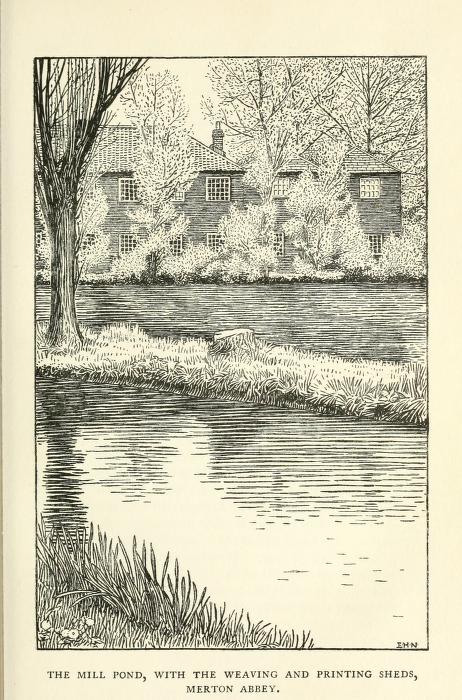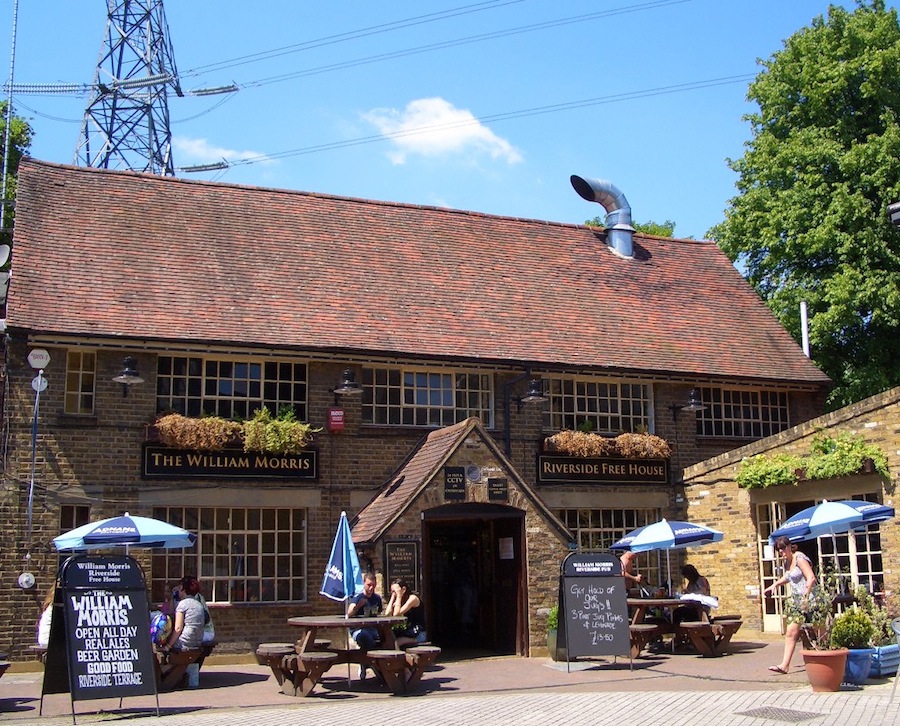Photographs and scans by the author. You may use the images for any scholarly or educational purpose as long as you (1) credit the source and (2) link your document to this URL in a web document or cite the Victorian Web in a print one. [Click on the images to enlarge them.]

The site at Abbey Mills, Merton, beside the River Wandle.
One Monday in March 1881, William Morris and his close friend William De Morgan went to look at some premises for workshops in Merton, which was then in Surrey — convenient enough from central London, though difficult to get to from Kelmscott House in Twickenham. These premises were "buildings used for calico printing since 1752," as a sign there now reports. First set up by Huguenot refugees who had settled in the area, they had fallen out of use by this time. But they held distinct possibilities for Morris. As the sign, seen on the right below, goes on to explain through some nettles, "Here stood the Merton Abbey Works of William Morris, established in 1881...."

In his biography of Morris, John Mackail points out the importance of the river: "The river Wandle, clear and beautiful then, and even now but little spoilt, runs through [the print works], turning a water wheel and supplying water of the special quality required for madder-dyeing. This was one of the prime requisites, and limited the choice of sites materially" (34). De Morgan recalled that they took water samples away to analyse the quality of the water, and see if it was fit for Morris's purpose. Fortunately it was, and the move went head.
Apart from the water-wheel and wheelhouse, the latter dating from about 1860, there was a spacious seven-acre site — including a meadow, orchard and vegetable garden — and a house with a flower garden at the rear going down to the river. There were also some big (two-storey) wooden sheds with red-tiled roofs. De Morgan was not going to share the site, but would establish a separate one a short walk away for his ceramic work (see Goodman 18).


Left: The water-wheel. Right: The notice over the wheelhouse entrance.
Although there were already some buildings, it took quite a while to sort things out. Morris needed power for his kilns, and the works needed to be adapted for his particular needs:
roofs had to be heightened to give free space for looms, and foundations trenched and puddled to keep out damp ... besides the heavy work of furnishing, the building of carpet-looms, the digging and lining of pits for indigo vats, and the general adaptation of both buildings and grounds to their new uses. [Mackail 36]
The re-tiling, re-flooring, and the sinking of vats as well as the installation of all other necessary equipment, must have taken a great investment of thought, energy and of course money.



Illustrations of Merton Abbey from Mackail. Left to right: (a) The mill pond, with the weaving and printing sheds (facing p.34). (b) The glass-painting sheds from the dye-house (facing p.42). (c) The chintz-printing room (facing p.56).
When the complex was completed, the new arrangements included rooms for Morris to stay when it was more convenient to spend the night there, an office and caretaker's house, and next to that a drawing and design room, followed by the apprentices' dormitory. One two-storey shed had the dye vats on the ground floor, and a stained glass studio on floor above. The weaving shed was just outside this building, while on the opposite bank of the river, overlooking the millpond, was a large shed with the carpet and tapestry looms on the ground floor and a room for fabric printing on the first floor (see Saxby 14).
It must have been impressive, and indeed needed to be: would-be customers would come to look over the premises before buying. They were particularly interested in "medieval style high-warp looms" and also "the enormous scale of many of the tapestries" (Drake 22). From these workshops came many of the designs for which Morris is most famous, such as Rose and Thistle, Brother Rabbit and the Thames tributary designs, such as Wey and (naturally) the very beautiful Wandle, shown on the right at the end here.



The Abbey Mills now, overshadowed by electricity pylons, but still a popular venue. Left to right: (a) The William Morris Pub. (b) The pan-tiled central pavilion. (c) A two-storey building now housing restaurants.
Apart from the nineteenth-century water-wheel and the earlier wheelhouse, the surviving buildings here are the old brick-, flint- and stone-built colour house, dating from 1742, and altered in Morris's time, and the adjoining late nineteenth-century block printing rooms. Something of the southern part of Liberty's workshop, which followed Morris's, also survives, but even that has been largely rebuilt (Cherry and Pevsner 414). "Merton Abbey Mills" has now been transformed into a leisure space. It hosts a crafts market, holds a regular summer music festival, and puts on plays for children, comedy and music shows, and so on. Still, there is something in the riverside site itself, with its cluster of buildings, that seems reminiscent of those days of inspired and industrious craftsmanship.

Morris's Wandle design, named after the river at the Merton Abbey Works.
Sources
Cherry, Bridget, and Nikolaus Pevsner. London 2: South. The Buildings of England series. New Haven and London: Yale University Press, 2002.
Drake, Jane. William Morris: An Illustrated Life (Pitkin Guide). Andover: Pitkin, 1996.
Goodman, Judith. "William De Morgan at Merton Abbey." William Morris Society paper, available on the web. 6 October 2015.
Mackail, John William. The Life of William Morris. Vol. II. London and New York: Longman, Green and Co., 1899. Internet Archive. Contributed by Robarts Library, University of Toronto. Web. 6 October 2015.
Saxby, David. William Morris at Merton. London: Museum of Archeology, 1996.
Created 6 October 2015